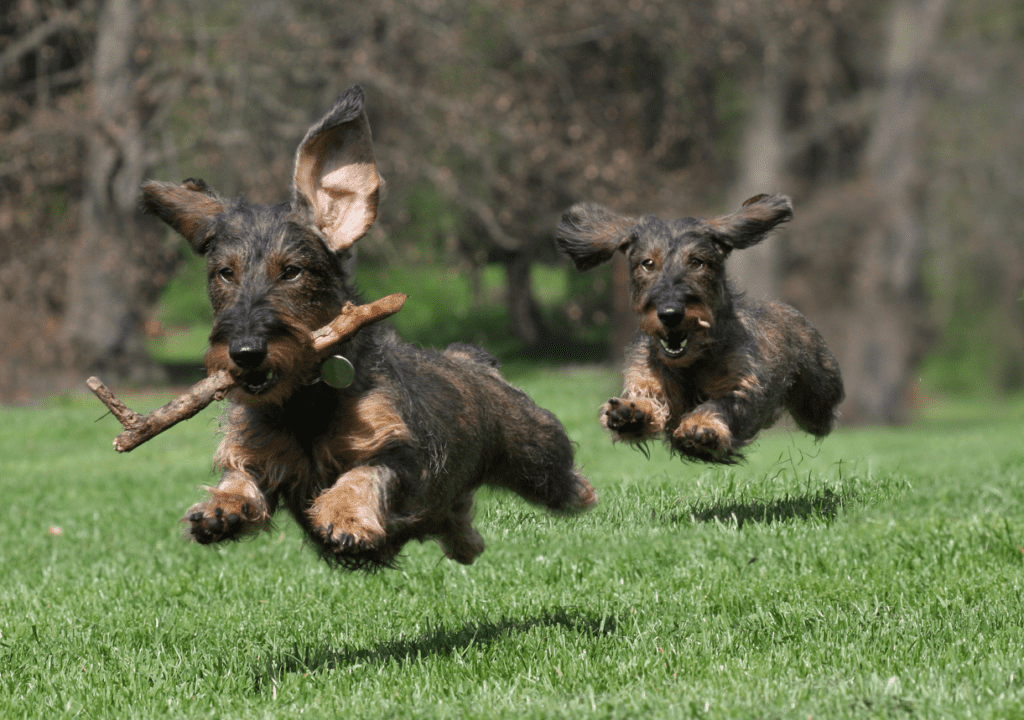Dachshunds are hunting dogs. They were initially bred to hunt small prey, such as badgers and foxes. Miniature dachshunds, on the other hand, were bred to hunt smaller game such as rodents, prairie dogs, and rabbits. Due to their small size and agility, dachshunds make excellent hunting dogs.

Origin of the Dachshund
The dachshund breed originated in the 17th century and was used for hunting badgers and other underground animals. The name “dachshund” comes from the German words “Dachs” and “Hund”, which mean “badger” and “hound” respectively.
Despite their short stature, dachshunds have strong legs that enable them to track down a variety of prey. Their physical characteristics, such as their ability to dig and enter burrows, made them excellent hunters.
In addition to this, dachshunds were bred to be courageous and tenacious, which allowed them to catch swift-moving animals like rabbits and ferrets.
Related Post: Hiking and Camping with a Dachshund

What Are Dachshunds Used For Today?
Dachshunds are no longer solely used for hunting; they are employed in various roles. Their keen sense of smell and determined nature make them perfect for different scent-work tasks, such as search and rescue, drug detection, and explosive detection. Furthermore, dachshunds are still popular hunting dogs, especially for small prey like rabbits and rodents.
Apart from these roles, dachshunds are also frequently used as therapy dogs. Their small size allows them to visit patients in hospitals and nursing homes with ease. Additionally, their gentle nature makes them ideal companions for people who are feeling lonely or down.
Related post: What were dachshunds bred for?
What Are Dachshunds Preferred Preys?
Dachshunds, known for their natural digging instincts, are talented at hunting animals that live underground or hide inside burrows. While they were originally bred for specific prey, it’s essential to note that there are two types of dachshunds: standard and miniature, each with distinct hunting preferences.
Standard Dachshunds: The original breed, standard dachshunds, were initially bred to pursue larger prey like foxes and badgers. These dogs boast muscular legs, providing the strength and endurance needed for extended chases. Their elongated bodies enable them to navigate narrow burrows efficiently. Today, standard dachshunds are often used in deer hunting, particularly for blood-tracking wounded prey. They can also pursue smaller animals such as rabbits and groundhogs.
Miniature Dachshunds: Bred later with a focus on smaller animals, miniature dachshunds target prey like rabbits, moles, and prairie dogs. Their short legs, proportionate to their bodies, contribute to their agility and speed. Their smaller size allows them to access tighter spots, making them efficient hunters of smaller game.
Do Dachshunds Catch Rats? While dachshunds weren’t initially created to hunt rodents, they have proven to be effective rat and mouse catchers. Despite the shift from a hunting role to domestic companionship, dachshunds, with their small size and short legs, still exhibit remarkable skills in tracking, chasing, and trapping rodents. Although not officially categorized as “ratter dogs,” they have adapted well to urban environments and farms where vermin control is necessary.
Related post: Standard Dachshund vs Miniature Dachshund
Final thoughts
n conclusion, the dachshund’s rich history as a hunting dog, dating back to the 17th century, has shaped their distinctive characteristics and capabilities. Originally bred for hunting badgers and foxes, the breed’s name itself reflects its purpose. Despite their small stature, dachshunds possess strong legs, determination, and courage, making them adept hunters of various prey.
While their traditional role as hunting companions has evolved, dachshunds continue to excel in diverse fields today. Their keen sense of smell and unwavering determination have found applications in scent-work tasks like search and rescue, drug detection, and explosive detection. Moreover, dachshunds remain valued in their traditional hunting roles, particularly for pursuing small prey like rabbits and rodents.
Beyond their hunting prowess, dachshunds have embraced new roles in society, becoming cherished therapy dogs due to their small size and gentle nature. They bring comfort and companionship to patients in hospitals and nursing homes, showcasing the breed’s adaptability and versatility.
In essence, whether as skilled hunters or loving therapy companions, dachshunds embody a remarkable blend of history, capability, and adaptability that has endeared them to countless households around the world.
Read more about the history of dachshunds: The History and Origins of the Dachshund
Recent Posts
Calculate the perfect food portions for your dachshund with our specialized calculator. Get customized feeding recommendations based on size, age, and activity level to support your wiener dog's back...
Looking for the perfect gift for a proud dachshund mom? We’ve rounded up the cutest dachshund shirts that celebrate your love for wiener dogs in style. Whether you’re shopping for yourself or a...



